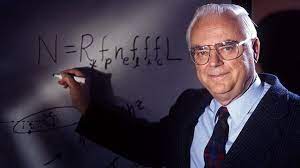
Frank Drake ’51, astronomy pioneer, dies at 92
Frank Drake ’51, an old Astronomy Cornell professor who inspired millions of people to share his desires to find life on another planet, died on September 2. He is 92 years old.
Drake spent 20 years in Cornell, from 1964 to 1984; Dia diangkat sebagai Profesor Astronomi Goldwin Smith pada tahun 1976. Selama waktu itu dia menjabat sebagai Direktur Cornell dari Arecibo Observatory di Puerto Rico dan, kemudian, sebagai direktur pendiri Pusat Astronomi dan Ionosfer Nasional (NAIC), yang berbasis Cornell, Cornell, Cornell, Cornell , Cornell, based in Cornell, Cornell, Cornell, Cornell, The Ionosphere (NAIC), Cornell Cornell Cornell Management Organization for Arecibo Observatory.
“Frank Drake is a pioneer of radio astronomy and the search for space intelligence using radio telescopes,” said fellow astronomer Jonathan Lunine. “During his term of office in Cornell, Arecibo became a true astronomy observatory and radar planetary facility which then made a in -depth discovery of our cosmos and the planet environment,” said Lunine, Professor David C. Duncan in Physical Science and Chair of the Astronomy Department in the College of Arts and Sciences Knowledge.
While Drake is the Director of Observatory Arecibo, Pulsars, quickly rotates the neutron star which is the result of a supernova explosion from big stars, found by Jocelyn Bell in England. Arecibo is a perfect telescope for learning objects full of puzzles, and Drake takes the opportunity, which involves many Cornell Postgraduate students in the new and interesting field of radio astronomy.
Drake began to investigate the possibility, while the Director, from a large increase in the telescope in Arecibo which will greatly increase the frequency range by replacing the surface of the original wire mesh with aluminum panels. As Director of Naic, he enthusiastically searched for funds from the National Science Foundation for this project, which was completed in late 1974, greatly expanded the ability of the telescope in the radio and radar astronomy. In a letter to Alam, Drake called it “The most attractive and cost -effective improvement for world astronomy equipment, and is one of the most promising science projects in general.” Towards the end of his time as Director of Naic in 1981, Drake initiated a study to improve the large telescope, which was finally completed in the mid-1990s.
While working at the Green Bank Observatory in West Virginia in 1960, Drake initiated the first serious effort to detect smart signals from planets around other stars, what is now known as an extra-terrestrial intelligence search (SETI). He called it “Project Ozma” after L. Frank Baum’s Queen of Oz. In the experiment, Drake used a radio telescope to examine stars -stars Tau Ceti and Epsilon Eridani, but he did not find a note signal. This is the beginning of a lifetime involvement with Seti.
In 1974 at the dedication event to improve the Arecibo telescope, Drake sent the first directed message into space to space, using the new radar transmitter of the observatory. The message contains some very basic information about humanity, including representation of the fundamental chemicals of life, formulas for DNA, rough diagrams of our solar system and simple pictures of humans and Arecibo telescopes.
While there are a large number of people in Arecibo for the event, others criticized Drake for sending messages. Some even suggest that sending messages like that is dangerous, because it might attract the attention of hostile aliens.

